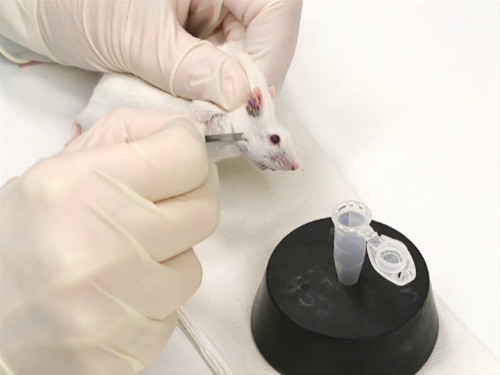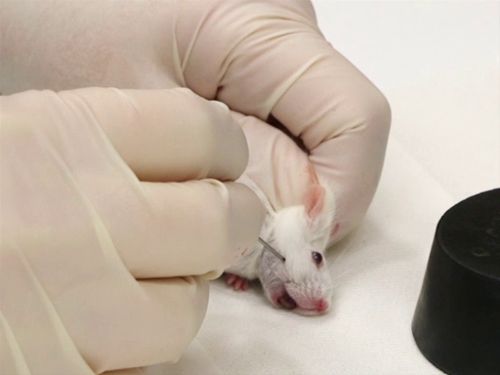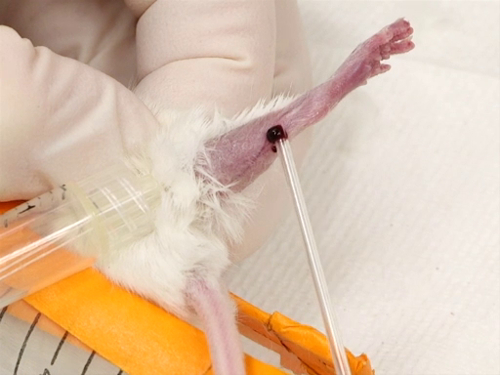Retirada de Sangue II
Visão Geral
Fonte: Kay Stewart, RVT, RLATG, CMAR; Valerie A. Schroeder, RVT, RLATG. Universidade de Notre Dame, IN
A coleta de sangue de camundongos e ratos para análise pode ser feita através de uma variedade de métodos. Cada método de coleta tem variações no tipo de contenção necessária, na invasividade do procedimento e na necessidade de um anestésico geral. 1 Historicamente, o uso da cavidade sinusal retro-orbital tem sido utilizado, mas não sem debate. A controvérsia relacionada aos potenciais danos teciduais, ou mesmo cegueira, causada por sangramentos retro-orbitais levou ao desenvolvimento de métodos de sangramento facial e submandibular em camundongos. A coleta de sangue da veia safena em camundongos e ratos é outra técnica que foi desenvolvida. Esses procedimentos não requerem anestesia e, portanto, são adequados quando o uso de anestésicos pode confundir resultados sanguíneos ou outros dados.
Procedimento
1. Veia facial sangra em camundongos
- Equipamento
- A coleta de sangue é de uma captura grátis em um tubo de sangue ou um tubo Eppendorf. Em alguns casos, é desejável coletar sangue diretamente em tubos hematócritos.
- As lancetas goldenrod serão selecionadas com base no tamanho apropriado para o animal de acordo com a idade e o sexo.
- As lancetas são selecionadas de acordo com a idade/tamanho dos ratos da seguinte forma:
Lancet de 4mm: camundongos de 3-4 semanas de idade (menos de 15 gr
- As lancetas são selecionadas de acordo com a idade/tamanho dos ratos da seguinte forma:
Aplicação e Resumo
O método de coleta de sangue pode causar uma variação na análise da amostra. O nível de habilidade do técnico que realiza a coleta de amostras tem impacto na qualidade da amostra e no bem-estar do animal. O uso de anestésicos também pode afetar a qualidade da amostra. Os métodos aqui descritos são todos realizados sem o uso de anestesia, assim essa variável foi eliminada. Além disso, todas essas técnicas podem ser utilizadas para amostragem serial com mínimo desconforto ao animal.
Referências
- Fernandez, I., Arantza, P., Del Teso, N., Perez, V. and Rodriguez-Cuesta, J. 2010. Clinical biochemistry parameters in C57BL/6J mice after blood collection from the submandibular vein and retroorbital plexus. Journal of American Association of Laboratory Animal Science. 49:2. 202-210.
- Joslin, O.T. 2009. Blood collection techniques in exotic small animals. Journal of Exotic Pet Medicine. 18:2. 117-139.
- Hem, A., Smith, A.J. and Solberg, P. 1998. Saphenous vein puncture for blood sampling of the mouse, rat, hamster, gerbil, guinea pig, ferret and mink. Laboratory Animals. 32. 364-368.
- Diehl, K-H., Hull, R., Morton, D., Pfister, R. Rabemampianina, Y., Smith, D., Vidal, J-M., and van de Vorstenbosch, C. 2001. A good practical guide to the administration of substances and removal of blood, including routes and volumes. Journal of Applied Toxicology. 21. 15-23.
Tags
Pular para...
Vídeos desta coleção:

Now Playing
Retirada de Sangue II
Lab Animal Research
72.8K Visualizações

Técnicas de manuseio e contenção de roedores
Lab Animal Research
173.4K Visualizações

Procedimentos de Cuidados Básicos
Lab Animal Research
27.7K Visualizações

Fundamentos da Reprodução e Desmame
Lab Animal Research
35.6K Visualizações

Identificação de roedores I
Lab Animal Research
54.5K Visualizações

Identificação de Roedores II
Lab Animal Research
25.5K Visualizações

Administração de Composto I
Lab Animal Research
100.0K Visualizações

Administração de Composto II
Lab Animal Research
34.7K Visualizações

Administração de Composto III
Lab Animal Research
31.3K Visualizações

Administração de Composto IV
Lab Animal Research
51.3K Visualizações

Retirada de Sangue I
Lab Animal Research
170.9K Visualizações

Indução e Manutenção da Anestesia
Lab Animal Research
50.0K Visualizações

Considerações para cirurgia de roedores
Lab Animal Research
22.4K Visualizações

Necropsia diagnóstica e coleta de tecidos
Lab Animal Research
57.8K Visualizações

Coleta de Tecido Estéril
Lab Animal Research
34.7K Visualizações
Copyright © 2025 MyJoVE Corporation. Todos os direitos reservados



